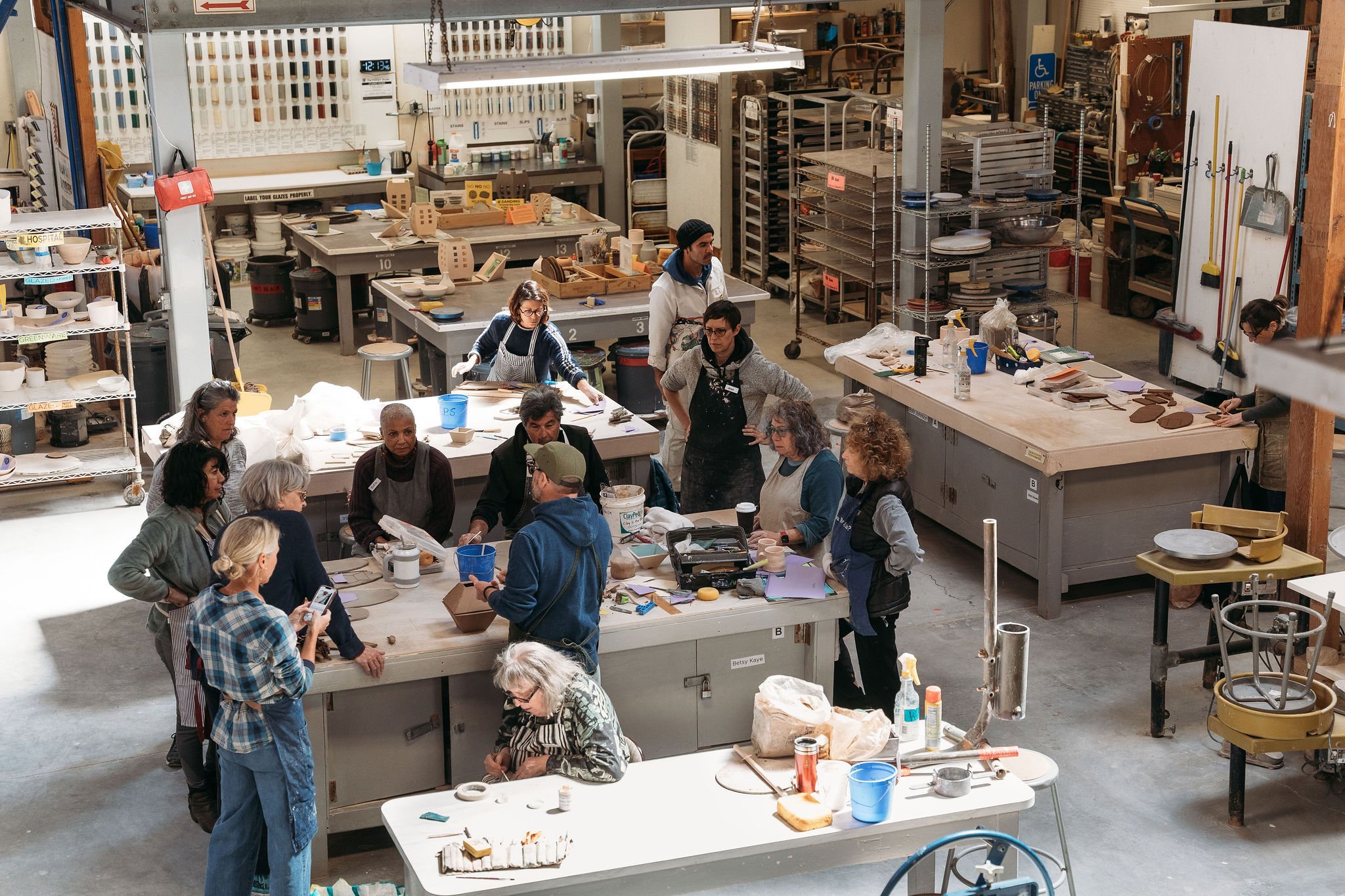SILICA DUST – HEALTH AND SAFETY PROTOCOLS
Silica dust is an unavoidable hazard in every ceramics studio, posing significant risks to the health and well-being of members and students. Silica, a naturally occurring mineral found in clay, sand, and other materials used in ceramics, becomes airborne during various studio activities such as mixing clay, shaping pottery, sanding dry clay, glazing, and firing kilns. Inhaling silica dust can lead to severe health complications, including respiratory diseases such as silicosis, lung cancer, and other respiratory ailments. This essay will explore the dangers of silica dust exposure in ceramic studios, its health effects, preventive measures, and the importance of creating safe working environments for artists.
Firstly, it’s crucial to understand the composition of silica and how it becomes airborne in ceramic studios. Silica, also known as silicon dioxide (SiO2), is a common component of clay, quartz, and other materials used in pottery making. When these materials dry and are manipulated through processes like mixing, cutting, grinding, or sanding, silica particles are released into the air as respirable crystalline silica dust. These fine particles are small enough to penetrate deep into the lungs when inhaled, where they can cause damage over time.
In wet form, crystalline silica in clay and glaze poses no health problems.
One of the most significant health risks associated with silica dust exposure is silicosis, a progressive and incurable lung disease. Silicosis develops gradually, often over many years of exposure to silica dust. The inhalation of silica particles causes inflammation and scarring in the lungs, leading to symptoms such as coughing, shortness of breath, fatigue, and chest pain. In advanced stages, silicosis can result in severe respiratory impairment and even death. Additionally, prolonged exposure to silica dust has been linked to an increased risk of lung cancer, tuberculosis, and other respiratory infections.
Furthermore, silica dust exposure can have detrimental effects on the overall respiratory system. Chronic inhalation of silica particles can lead to the development of chronic obstructive pulmonary disease (COPD), asthma, and other respiratory conditions.
Despite the known health risks, many ceramic artists may underestimate the dangers of silica dust or fail to implement adequate safety measures in their studios. Factors such as poor ventilation, inadequate personal protective equipment (PPE), and lack of awareness contribute to increased exposure levels among artists. In some cases, artists may prioritize creativity and productivity over their own health, neglecting proper safety protocols in the studio.
Sources of silica in and around the studio:
All types of clay and clay bodies (including casting slips and decorating slips)
Bisqueware
Glaze materials (e.g., all feldspars, talc, Zircopax, etc.)
Glaze/glaze waste
Underglaze/engobes (including crayons and pencils)
TPS decorating stains and oxides
Terra sigillata
Kilns
Kaowool/Fiberfrax (what Geil kilns walls are made of)
Kiln wash and wadding
Kiln posts, shelves, and bricks
To mitigate the risks associated with silica dust exposure, it is essential for The Potters’ Studio to recommend, implement, and follow safety measures and protocols. Ventilation plays a crucial role in reducing airborne silica dust levels in the studio. Using wet methods such as wet mopping, wet brushing, or wet grinding can help suppress dust formation and minimize exposure during ceramic activities.
Personal protective equipment (PPE) is another vital component of silica dust control in ceramic studios. Artists should wear appropriate respiratory protection, such as N95 respirators or powered air-purifying respirators (PAPRs), when working with materials that generate silica dust. Additionally, wearing gloves, long-sleeved shirts, and goggles can provide protection against skin and eye irritation from dust exposure.
It is important that all members and students understand the risks involved with handling not just clay, but dry clay and materials in particular.
Common paths of exposure include, but are not limited to:
Dry clay and glaze on clothes, shoes, and aprons
Sanding and trimming of greenware
Dirty unmaintained cubbies and tools
Dry trim under and around work areas
Because education and training are essential for raising awareness about the dangers of silica dust and promoting safe working practices in ceramic studios, The Potters’ Studio provides education on the proper handling, storage, and disposal of materials containing silica and proper use of PPE. By empowering members and students with knowledge and skills to protect themselves, The Potters’ Studio can create a culture of safety and responsibility that protects all artists and studio employees from the hazards of airborne silica dust.
The Potters’ Studio follows comprehensive safety measures, including proper ventilation, use of personal protective equipment, and education and training for members and students. By prioritizing safety and creating a culture of awareness, the studio can ensure the health and longevity of our artistic community.
What we do to mitigate dust
· Open the roller sliding doors
· Clean and mop the wedging area twice daily
· Have the floors cleaned weekly
· Hold cleaning days 4 times yearly
· Clean behind the yellow recycle bin 3 times weekly
· Vacuum less worn areas frequently
· Clean ware shelves when empty
· Doom monthly
· Clean bats as needed
Things you can do to help the Studio mitigate dust
· Clean your workspace thoroughly after every use
· Mop your workspace every time you leave
· Sand outside (never, never sand inside)
· Clean up after sanding outside
· Clean your cubby monthly
· Clean bats when you use them
· Move your work in a timely fashion (resting ware collects dust)
· Clean all towels, aprons, and clothes often
· Wipe down the wedging table when you are done
· Always mop, NEVER sweep
· Work cleanly
· Attend Member clean-ups
· Leave all work areas cleaner than you found them
· Wipe down the whole wheel, not just the horizontal surface
· Wash your hands frequently


